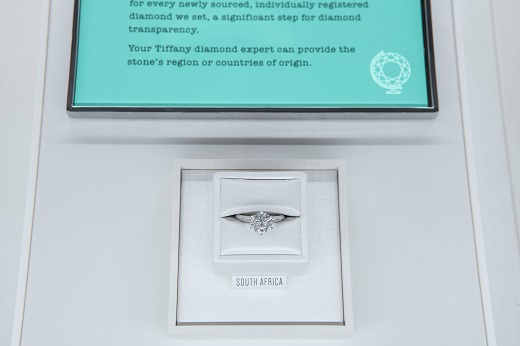Tiffany to Disclose Origin of Diamonds
 RAPAPORT... Tiffany & Co. has begun disclosing the geographical originof its diamonds to consumers, pledging to go beyond the standardresponsible-sourcing methods prevalent in the industry. The company will provide information on stones' regions orcountries of origin in its engagement-ring display cases, starting Wednesday.For other diamonds, customers will be able to obtain provenance details byasking a sales or customer-service representative. The jeweler will stopsourcing diamonds with unknown provenance, even if they carry a guarantee ofresponsible sourcing. The move raises the bar for suppliers, who previously had tocomply with Tiffany's Diamond Source Warranty Protocol confirming stones weren'ttainted by human-rights concerns. They'll now have to offer more by stating thegeographical source. "Beyond general assurances of 'conflict-free,' Tiffanybelieves that knowing provenance is critical to ensuring its diamonds are amongthe most responsibly sourced in the world," the company said in a statementWednesday. The retailer will add sourcing information to its TiffanyDiamond Certificates later in the first quarter. In 2020, it will begin sharingdata on the process a stone went through when it was cut and polished, such asthe location of the workshop. The program - enabled through a unique laser inscription oneach stone - applies to all newly sourced diamonds of 0.18 carats and larger."Heritage" stones of unknown provenance will come with confirmation they weresourced with industry-leading practices, Tiffany added.Between 80% and 90% of Tiffany's polished diamonds weighing more than 0.18 carats are prepared through its Laurelton Diamonds subsidiary, which has manufacturing operations in Belgium, Botswana, Mauritius, Vietnam and Cambodia. The other 10% to 20% is sourced from external suppliers. Laurelton has rough-supply agreements with De Beers, Alrosa, Dominion Diamond Mines and Rio Tinto, and thus sources its goods from mines in Botswana, Canada, Namibia, Russia and South Africa.De Beers aggregates its rough production from Botswana, Namibia, Canada and South Africa at its Botswana sorting facility, enabling clients to disclose that their supply came from one of those four countries. The miner recently approved changes to that policy, as reported by Rapaport News this week. Tiffany noted that in the case of "one trusted supplier," diamonds may be labeled "Botswana sort.""Our clients want and deserve to know where their most valuable, most cherished diamond jewelry is from, and how it came to be," said Tiffany CEO Alessandro Bogliolo. "There should be nothing opaque about Tiffany diamonds." Image: A Tiffany diamond ring with source of origin. (Tiffany & Co.)
RAPAPORT... Tiffany & Co. has begun disclosing the geographical originof its diamonds to consumers, pledging to go beyond the standardresponsible-sourcing methods prevalent in the industry. The company will provide information on stones' regions orcountries of origin in its engagement-ring display cases, starting Wednesday.For other diamonds, customers will be able to obtain provenance details byasking a sales or customer-service representative. The jeweler will stopsourcing diamonds with unknown provenance, even if they carry a guarantee ofresponsible sourcing. The move raises the bar for suppliers, who previously had tocomply with Tiffany's Diamond Source Warranty Protocol confirming stones weren'ttainted by human-rights concerns. They'll now have to offer more by stating thegeographical source. "Beyond general assurances of 'conflict-free,' Tiffanybelieves that knowing provenance is critical to ensuring its diamonds are amongthe most responsibly sourced in the world," the company said in a statementWednesday. The retailer will add sourcing information to its TiffanyDiamond Certificates later in the first quarter. In 2020, it will begin sharingdata on the process a stone went through when it was cut and polished, such asthe location of the workshop. The program - enabled through a unique laser inscription oneach stone - applies to all newly sourced diamonds of 0.18 carats and larger."Heritage" stones of unknown provenance will come with confirmation they weresourced with industry-leading practices, Tiffany added.Between 80% and 90% of Tiffany's polished diamonds weighing more than 0.18 carats are prepared through its Laurelton Diamonds subsidiary, which has manufacturing operations in Belgium, Botswana, Mauritius, Vietnam and Cambodia. The other 10% to 20% is sourced from external suppliers. Laurelton has rough-supply agreements with De Beers, Alrosa, Dominion Diamond Mines and Rio Tinto, and thus sources its goods from mines in Botswana, Canada, Namibia, Russia and South Africa.De Beers aggregates its rough production from Botswana, Namibia, Canada and South Africa at its Botswana sorting facility, enabling clients to disclose that their supply came from one of those four countries. The miner recently approved changes to that policy, as reported by Rapaport News this week. Tiffany noted that in the case of "one trusted supplier," diamonds may be labeled "Botswana sort.""Our clients want and deserve to know where their most valuable, most cherished diamond jewelry is from, and how it came to be," said Tiffany CEO Alessandro Bogliolo. "There should be nothing opaque about Tiffany diamonds." Image: A Tiffany diamond ring with source of origin. (Tiffany & Co.)